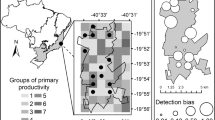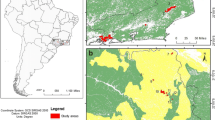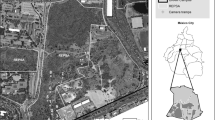Abstract
Domestic dogs (Canis familiaris) are the most common carnivore species in natural ecosystems worldwide. They are of considerable concern for wildlife conservation, particularly in the absence of predators. However, we are only beginning to understand the ecology of free-ranging dogs, and even less is known in sub-Antarctic environments. Here, we used camera-trap data to assess space use of free-ranging dogs on a sub-Antarctic island in the Cape Horn Biosphere Reserve, southern Chile, which lacks native terrestrial carnivores. We predicted free-ranging dogs to be associated with human settlements, trails, and roads and to prefer open habitats over forest for the ease of movement. We obtained 67 independent dog records of 62 individuals over 3909 camera-trap days from 200 sites. Single-species single-season occupancy models revealed that both rural/village dogs, as well as putative feral dogs chose peatbogs over forest, but their preference for settlements and roads was less pronounced and inconsistent among dog categories. Our findings revealed evidence for a reproducing feral dog population on Navarino Island that may be sustained by recruits from rural/village dogs, as identical sites were visited by both dog categories. However, due to a higher occupancy with proximity to human dwellings, the dependence of feral dogs on human resources remain uncontested. In light of the penetration of dogs into pristine sub-Antarctic habitats and their possible impacts on native vulnerable prey, we recommend the implementation of responsible pet-ownership regulations, as well as ethically-approved control actions for feral dogs to protect one of the planet’s last wilderness areas.





Similar content being viewed by others
References
Anderson CB, Rozzi R, Torres-Mura JC et al (2006) Exotic vertebrate fauna in the remote and pristine sub-Antarctic Cape Horn Archipelago, Chile. Biodivers Conserv 15:3295–3313. https://doi.org/10.1007/s10531-005-0605-y
Atickem A, Bekele A, Williams SD (2010) Competition between domestic dogs and Ethiopian wolf (Canis simensis) in the Bale Mountains National Park, Ethiopia. Afr J Ecol 48:401–407. https://doi.org/10.1111/j.1365-2028.2009.01126.x
Barnett BD (1986) Eradication and control of feral and free-ranging dogs in the Galapagos Islands. In: Proceedings of the twelfth vertebrate pest conference, pp 358–368
Bartón K (2017) Multi-model inference, pp 1–73
Boitani L, Francisci F, Ciucci P, Andreoli G (2017) The ecology and behavior of feral dogs: a case study from central Italy. In: Serpell JA (ed) The domestic dog. Its evolution, behavior and interactions with people. Cambridge University Press, Cambridge, pp 342–368
Burnham KP, Anderson DR (2002) Model selection and multimodel inference: a practical information—theoretic approach, 2nd edn. Springer, New York
Butler JR, Bingham J (2000) Demography and dog-human relationships of the dog population in Zimbabwean communal lands. Vet Rec 147:442–446. https://doi.org/10.1136/vr.147.16.442
Causey MK, Cude CA (1980) Feral dog and white-tailed deer interactions in Alabama. J Wildl Manag 44:481–484
Claridge AW, Mills DJ, Hunt R et al (2009) Satellite tracking of wild dogs in south-eastern mainland Australian forests: implications for management of a problematic top-order carnivore. For Ecol Manage 258:814–822. https://doi.org/10.1016/j.foreco.2009.05.030
Corti P, Wittmer HU, Festa-Bianchet M (2010) Dynamics of a small population of endangered huemul deer (Hippocamelus bisulcus) in Chilean Patagonia. J Mammal 91:690–697. https://doi.org/10.1644/09-MAMM-A-047.1.Key
Courchamp F, Langlais M, Sugihara G (1999) Cats protecting birds: modelling the mesopredator release effect. J Anim Ecol 68:282–292. https://doi.org/10.1046/j.1365-2656.1999.00285.x
Couve E, Vidal C, Ruiz J (2016) Aves de Chile, sus Islas Oceánicas y Península Antártica, 1st edn. Editorial FS, Punta Arenas
Crego RD, Jiménez JE, Rozzi R (2016) A synergistic trio of invasive mammals? Facilitative interactions among beavers, muskrats, and mink at the southern end of the Americas. Biol Invasions 18:1923–1938. https://doi.org/10.1007/s10530-016-1135-0
Crowley SL, Hinchliffe S, McDonald RA (2017) Conflict in invasive species management. Front Ecol Environ 15:133–141. https://doi.org/10.1002/fee.1471
Daniels TJ, Bekoff M (1989) Spatial and temporal resource use by feral and abandoned dogs. Ethology 81:300–312. https://doi.org/10.1111/j.1439-0310.1989.tb00776.x
Doherty TS, Dickman CR, Glen AS et al (2017) The global impacts of domestic dogs on threatened vertebrates. Biol Conserv 210:56–59. https://doi.org/10.1016/j.biocon.2017.04.007
Dos Santos CLA, le Pendu Y, Giné GAF et al (2018) Human behaviors determine the direct and indirect impacts of free-ranging dogs on wildlife. J Mammal 99:1261–1269. https://doi.org/10.1093/jmammal/gyy077
Dubois S, Fenwick N, Ryan EA et al (2017) International consensus principles for ethical wildlife control. Conserv Biol 31:753–760. https://doi.org/10.1111/cobi.12896
Dürr S, Dhand NK, Bombara C et al (2017) What influences the home range size of free-roaming domestic dogs? Epidemiol Infect. https://doi.org/10.1017/S095026881700022X
Estévez RA, Anderson CB, Pizarro JC, Burgman MA (2015) Clarifying values, risk perceptions, and attitudes to resolve or avoid social conflicts in invasive species management. Conserv Biol 29:19–30. https://doi.org/10.1111/cobi.12359
Fiske I, Chandler R (2015) Overview of unmarked: an R package for the analysis of data from unmarked animals. R Development Core Team, Vienna, pp 1–5
Fleschutz MM, Gálvez N, Peer G et al (2016) Response of a small felid of conservation concern to habitat fragmentation. Biodivers Conserv 25:1447–1463. https://doi.org/10.1007/s10531-016-1118-6
Foster RJ, Harmsen BJ (2012) A critique of density estimation from camera-trap data. J Wildl Manage 76:224–236. https://doi.org/10.1002/jwmg.275
Garmin Ltd. (2017) BaseCamp software version 4.6.2
Gerencsér L, Vásárhelyi G, Nagy M et al (2013) Identification of behaviour in freely moving dogs (Canis familiaris) using inertial sensors. PLoS ONE 8:1–14. https://doi.org/10.1371/journal.pone.0077814
Gompper ME (2014) The dog-human-wildlife interface: assessing the scope of the problem. In: Gompper ME (ed) Free-ranging dogs & wildlife conservation, 1st edn. Oxford University Press, Oxford, pp 9–54
González BA (2010) ¿Qué problemas de conservación tienen las poblaciones de guanaco en Chile? Ambiente Forestal 9:28–38
Google Inc. (2017) Google Earth™. Imagery date September 2017
Green JS, Gipson PS (1994) Feral dogs. In: Hygnstrom SE, Timm RM, Larson GE (eds) The handbook: prevention and control of wildlife damage. University of Nebraska, Lincoln, NE, pp 1–7
Henn JJ, Anderson CB, Martínez Pastur G (2016) Landscape-level impact and habitat factors associated with invasive beaver distribution in Tierra del Fuego. Biol Invasions 18:1679–1688. https://doi.org/10.1007/s10530-016-1110-9
Hughes J, Macdonald DW (2013) A review of the interactions between free-roaming domestic dogs and wildlife. Biol Conserv 157:341–351. https://doi.org/10.1016/j.biocon.2012.07.005
IMCH (2015) Turismo Sustentable en Cabo de Hornos: Plan de Desarrollo Turístico 2015-2020. Comuna de Cabo de Hornos, Región de Magallanes y Antártica Chilena
Kolowski JM, Forrester TD (2017) Camera trap placement and the potential for bias due to trails and other features. PLoS ONE 12:1–20. https://doi.org/10.1371/journal.pone.0186679
Lacerda ACR, Tomas WM, Marinho-Filho J (2009) Domestic dogs as an edge effect in the Brasília national park, Brazil: interactions with native mammals. Anim Conserv 12:477–487. https://doi.org/10.1111/j.1469-1795.2009.00277.x
Linkie M, Dinata Y, Nugroho A, Haidir IA (2007) Estimating occupancy of a data deficient mammalian species living in tropical rainforests: sun bears in the Kerinci Seblat region, Sumatra. Biol Conserv 137:20–27. https://doi.org/10.1016/j.biocon.2007.01.016
MacKenzie DI, Reardon JT (2013) Occupancy methods for conservation management, 1st edn. Wiley, Hoboken
Mackenzie DI, Nichols JD, Royle JA et al (2006) Occupancy estimation and modeling: inferring patterns and dynamics of species ocurrence, 1st edn. Academic Press, London
Marks BK, Duncan RS (2009) Use of forest edges by free-ranging cats and dogs in an urban forest fragment. Southeast Nat 8:427–436
Meek PD (1999) The movement, roaming behaviour and home range of free-roaming domestic dogs, Canis lupus familiaris, in coastal New South Wales. Wildl Res 26:847. https://doi.org/10.1071/WR97101
Mella-Méndez I, Flores-Peredo R, Bolívar-Cimé B, Vázquez-Domínguez G (2019) Effect of free-ranging dogs and cats on medium-sized wild mammal assemblages in urban protected areas of a Mexican city. Wildl Res 46:669–678. https://doi.org/10.1071/WR19074
Moreira-Arce D, Vergara PM, Boutin S (2015) Diurnal human activity and introduced species affect occurrence of carnivores in a human-dominated landscape. PLoS ONE 10:1–19. https://doi.org/10.1371/journal.pone.0137854
O’Connell AF, Nichols JD, Karanth KU (2011) Camera traps in animal ecology: Methods and analyses, 1st edn. Springer, New York
Parsons AW, Bland C, Forrester T et al (2016) The ecological impact of humans and dogs on wildlife in protected areas in eastern North America. Biol Conserv 203:75–88. https://doi.org/10.1016/j.biocon.2016.09.001
Paschoal AMO, Massara RL, Santos JL, Chiarello AG (2012) Is the domestic dog becoming an abundant species in the Atlantic forest? A study case in southeastern Brazil. Mammalia 76:67–76. https://doi.org/10.1515/mammalia-2012-0501
Paschoal AMO, Massara RL, Bailey LL et al (2016) Use of Atlantic Forest protected areas by free-ranging dogs: estimating abundance and persistence of use. Ecosphere 7:1–15. https://doi.org/10.1002/ecs2.1480
Pisano E (1977) Fitogeografia de Fuego-Patagonia Chilena. Comunidades vegetales entre las latitudes 52 y 56° S. Anales del Instituto de La Patagonia (Chile) 8:121–246
QGIS Development Team (2017) Quantum GIS geographic information system. Open Source Geospatial Foundation Project
Ribeiro FS, Nichols E, Morato RG et al (2019) Disturbance or propagule pressure? Unravelling the drivers and mapping the intensity of invasion of free-ranging dogs across the Atlantic forest hotspot. Divers Distrib 25:191–204. https://doi.org/10.1111/ddi.12845
Rozzi R, Armesto JJ, Gutiérrez JR et al (2012) Integrating ecology and environmental ethics: earth stewardship in the southern end of the Americas. Bioscience 62:226–236. https://doi.org/10.1525/bio.2012.62.3.4
Ruiz-Izaguirre E, van Woersem A, Eilers KCHAM et al (2015) Roaming characteristics and feeding practices of village dogs scavenging sea-turtle nests. Anim Conserv 18:146–156. https://doi.org/10.1111/acv.12143
Sarkar R, Sau S, Bhadra A (2019) Scavengers can be choosers: a study on food preference in free-ranging dogs. Appl Anim Behav Sci 216:38–44. https://doi.org/10.1016/j.applanim.2019.04.012
Schuette P, Wagner AP, Wagner ME, Creel S (2013) Occupancy patterns and niche partitioning within a diverse carnivore community exposed to anthropogenic pressures. Biol Conserv 158:301–312. https://doi.org/10.1016/j.biocon.2012.08.008
Schüttler E, Klenke R, McGehee S et al (2009) Vulnerability of ground-nesting waterbirds to predation by invasive American mink in the Cape Horn Biosphere Reserve, Chile. Biol Conserv 142:1450–1460. https://doi.org/10.1016/j.biocon.2009.02.013
Schüttler E, Saavedra-Aracena L, Jiménez JE (2018) Domestic carnivore interactions with wildlife in the Cape Horn Biosphere Reserve, Chile: husbandry and perceptions of impact from a community perspective. PeerJ 6:e4124. https://doi.org/10.7717/peerj.4124
Scott MD, Causey K (1973) Ecology of Feral Dogs in Alabama. J Wildl Manag 37:253–265
Sepúlveda MA, Singer RS, Silva-Rodriǵuez E et al (2014) Domestic dogs in rural communities around protected areas: conservation problem or conflict solution? PLoS ONE 9:e86152. https://doi.org/10.1371/journal.pone.0086152
Sepúlveda M, Pelican K, Cross P et al (2015) Fine-scale movements of rural free-ranging dogs in conservation areas in the temperate rainforest of the coastal range of southern Chile. Mamm Biol 80:290–297. https://doi.org/10.1016/j.mambio.2015.03.001
Sielfeld K, Venegas C (1980) Poblamiento e impacto ambiental de Castor canadensis Kuhl, en Isla Navarino, Chile. Anales del Instituto de la Patagonia 11:247–257
Silva-Rodriguez EA, Sieving KE (2011) Influence of care of domestic carnivores on their predation on vertebrates. Conserv Biol 25:808–815. https://doi.org/10.1111/j.1523-1739.2011.01690.x
Silva-Rodríguez EA, Sieving KE (2012) Domestic dogs shape the landscape-scale distribution of a threatened forest ungulate. Biol Conserv 150:103–110. https://doi.org/10.1016/j.biocon.2012.03.008
Soto CA, Palomares F (2015) Human-related factors regulate the presence of domestic dogs in protected areas. Oryx 49:254–260. https://doi.org/10.1017/S0030605313000604
Srbek-Araujo AC, Chiarello AG (2008) Domestic dogs in Atlantic forest preserves of south-eastern Brazil: a camera-trapping study on patterns of entrance and site occupancy rates. Braz J Biol 68:771–779. https://doi.org/10.1590/S1519-69842008000400011
Stockwell DRB, Peterson AT (2008) Effects of sample size on the performance of species distribution models. Ecol Model 148:1–13
R Core Team (2017) R: a language and environment for statistical computing
Thorn M, Scott DM, Green M et al (2009) Estimating brown hyaena occupancy using baited camera traps. S Afr J Wildl Res 39:1–10. https://doi.org/10.3957/056.039.0101
Twardek WM, Peiman KS, Gallagher AJ, Cooke SJ (2017) Fido, Fluffy, and wildlife conservation: the environmental consequences of domesticated animals. Environ Rev 25:381–395
Vanak AT, Gompper ME (2009) Dogs Canis familiaris as carnivores: their role and function in intraguild competition. Mamm Rev 39:265–283. https://doi.org/10.1111/j.1365-2907.2009.00148.x
Vanak AT, Gompper ME (2010) Interference competition at the landscape level: the effect of free-ranging dogs on a native mesocarnivore. J Appl Ecol 47:1225–1232. https://doi.org/10.1111/j.1365-2664.2010.01870.x
Villatoro FJ, Naughton-Treves L, Sepúlveda MA et al (2018) When free-ranging dogs threaten wildlife: public attitudes toward management strategies in southern Chile. J Environ Manage. https://doi.org/10.1016/j.jenvman.2018.06.035
Warembourg C, Berger-González M, Alvarez D et al (2020) Estimation of free-roaming domestic dog population size: investigation of three methods including an Unmanned Aerial Vehicle (UAV) based approach. PLoS ONE 15:1–24. https://doi.org/10.1371/journal.pone.0225022
Wierzbowska IA, Hędrzak M, Popczyk B et al (2016) Predation of wildlife by free-ranging domestic dogs in Polish hunting grounds and potential competition with the grey wolf. Biol Conserv 201:1–9. https://doi.org/10.1016/j.biocon.2016.06.016
Woodroffe R, Donnelly CA (2011) Risk of contact between endangered African wild dogs Lycaon pictus and domestic dogs: opportunities for pathogen transmission. J Appl Ecol 48:1345–1354. https://doi.org/10.1111/j.1365-2664.2011.02059.x
Yoshizaki J, Pollock KH, Brownie C, Webster RA (2010) Modeling misidentification errors in capture-recapture studies using photographic identification of evolving marks. Ecology 90:3–9. https://doi.org/10.1371/journal.pbio.1000178
Young JK, Olson KA, Reading RP et al (2011) Is wildlife going to the dogs? Impacts of feral and free-roaming dogs on wildlife populations. Bioscience 61:125–132. https://doi.org/10.1525/bio.2011.61.2.7
Zanin M, Bergamaschi CL, Ferreira JR et al (2019) Dog days are just starting: the ecology invasion of free-ranging dogs (Canis familiaris) in a protected area of the Atlantic Forest. Eur J Wildl Res 65:1–10. https://doi.org/10.1007/s10344-019-1303-5
Zapata-Ríos G, Branch LC (2018) Mammalian carnivore occupancy is inversely related to presence of domestic dogs in the high Andes of Ecuador. PLoS ONE 13:1–17. https://doi.org/10.1371/journal.pone.0192346
Zuur AF, Ieno EN, Elphick CS (2009) A protocol for data exploration to avoid common statistical problems. Methods Ecol Evol. https://doi.org/10.1111/j.2041-210X.2009.00001.x
Acknowledgements
We would like to thank Lorena Saavedra for her kind help during the geoprocessing analysis and revision of dog photos. Thanks to Ramiro Crego for his valuable advice in all project phases. We would also like to thank Amy Wynia for checking the English of this manuscript. We are grateful to landowners and the Chilean Navy who allowed us to work on their lands. Camera-traps were kindly loaned from Jaime Jiménez (University of North Texas, USA) and Klaus Henle (Helmholtz Centre for Environmental Research-UFZ, Germany). Financial support was provided by the Chilean National Commission for Scientific and Technological Research (PAI-CONICYT, Call 2014, No. 79140024).
Author information
Authors and Affiliations
Corresponding author
Ethics declarations
Conflict of interest
The authors declare that they have no conflict of interest.
Research involving animals
The present research involved free-ranging dog presence data obtained through camera-traps, and only included the monitoring of animals in an indirect way, without direct contact.
Additional information
Publisher's Note
Springer Nature remains neutral with regard to jurisdictional claims in published maps and institutional affiliations.
Electronic supplementary material
Below is the link to the electronic supplementary material.
Rights and permissions
About this article
Cite this article
Contardo, J., Grimm-Seyfarth, A., Cattan, P.E. et al. Environmental factors regulate occupancy of free-ranging dogs on a sub-Antarctic island, Chile. Biol Invasions 23, 677–691 (2021). https://doi.org/10.1007/s10530-020-02394-3
Received:
Accepted:
Published:
Issue Date:
DOI: https://doi.org/10.1007/s10530-020-02394-3




